As Halloween approaches, there is no better treat than a spooky story or two! The recently published books in this week’s column include some whimsical and not-too-scary stories for younger children and suspenseful and chilling tales for older readers. Share these books with students to give them a ghoulishly good time.
Ages 4–8
Boo Who? Ben Clanton. 2017. Candlewick.
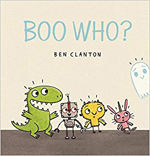 New to town, a little ghost named Boo is searching for some friends. Luckily, Boo meets T. Rex (a dinosaur), Gizmo (a robot), Wild (a monster), and Sprinkles (a unicorn rabbit). The four pals welcome him, but he has a hard time fitting in. Boo is not good at playing their favorite games, and this makes him sad. However, they are determined to find a way to help him fit in. How about a game of hide-and-seek? This playful read-aloud with expressive cartoon art will help young children see that differences are what make us special and that there are always ways to include new friends.
New to town, a little ghost named Boo is searching for some friends. Luckily, Boo meets T. Rex (a dinosaur), Gizmo (a robot), Wild (a monster), and Sprinkles (a unicorn rabbit). The four pals welcome him, but he has a hard time fitting in. Boo is not good at playing their favorite games, and this makes him sad. However, they are determined to find a way to help him fit in. How about a game of hide-and-seek? This playful read-aloud with expressive cartoon art will help young children see that differences are what make us special and that there are always ways to include new friends.
—RM
Creepy Pair of Underwear! Aaron Reynolds. Ill. Peter Brown. 2017. Simon & Schuster.
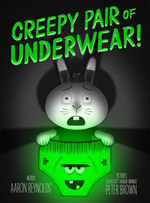 Children who loved Reynolds and Brown’s Creepy Carrots!, a 2013 Caldecott Honor book, will delight in Jasper Rabbit’s latest fright. When his mom takes him underwear shopping, Jasper insists he is not a little bunny anymore and begs for a pair of Creepy Underwear. When he is alone in his room that night, however, he finds that the “ghoulish, greenish glow” of the underwear is too scary. Desperate to get rid of the underwear, he tries everything from cutting it to shreds to mailing it to China. To Jasper’s horror, the Creepy Underwear keeps returning! Jasper finally devises a solution to his creepy undies problem that also helps him conquer his fear of the dark and proves he is a big rabbit after all. The black and white of the illustrations add a spooky tone and provide the perfect backdrop for the Day-Glo green underpants. The comical faces of the Creepy Underwear lend humor to this not-too-creepy story.
Children who loved Reynolds and Brown’s Creepy Carrots!, a 2013 Caldecott Honor book, will delight in Jasper Rabbit’s latest fright. When his mom takes him underwear shopping, Jasper insists he is not a little bunny anymore and begs for a pair of Creepy Underwear. When he is alone in his room that night, however, he finds that the “ghoulish, greenish glow” of the underwear is too scary. Desperate to get rid of the underwear, he tries everything from cutting it to shreds to mailing it to China. To Jasper’s horror, the Creepy Underwear keeps returning! Jasper finally devises a solution to his creepy undies problem that also helps him conquer his fear of the dark and proves he is a big rabbit after all. The black and white of the illustrations add a spooky tone and provide the perfect backdrop for the Day-Glo green underpants. The comical faces of the Creepy Underwear lend humor to this not-too-creepy story.
—DH
I Want to Be in a Scary Story. Sean Taylor. Ill. Jean Jullien. 2017. Candlewick.
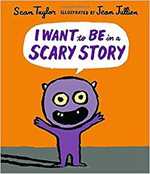 Little Monster, a purple monster with big yellow eyes, declares that he wants to be in a scary story, but he soon learns that witches, ghosts, and haunted houses might be too scary for him. What kind of story is just right for Little Monster? Could it be a funny story? The story is told as a dialogue between Little Monster and the writer, presented in alternating font colors—purple for Little Monster and black for the writer. The bold digital illustrations spookily and humorously reveal the evolution of the story, ending with a delightful surprise.
Little Monster, a purple monster with big yellow eyes, declares that he wants to be in a scary story, but he soon learns that witches, ghosts, and haunted houses might be too scary for him. What kind of story is just right for Little Monster? Could it be a funny story? The story is told as a dialogue between Little Monster and the writer, presented in alternating font colors—purple for Little Monster and black for the writer. The bold digital illustrations spookily and humorously reveal the evolution of the story, ending with a delightful surprise.
—SR
The Scariest Book Ever. Bob Shea. 2017. Disney-Hyperion.
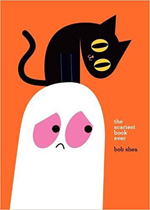 The narrator, a small ghost, would rather stay home than venture into the dark woods. After all, the woods might have scary things in it. Although the ghost wants you, the reader, to keep him company, you enter the woods. Upon your return, you tell him about the harmless things you saw, but he won’t believe you. When the ghost finally goes into the woods to see for himself, he is in for a fright and a surprise. Young children will enjoy journeying through this giggle-inducing story with brightly colored comical illustrations.
The narrator, a small ghost, would rather stay home than venture into the dark woods. After all, the woods might have scary things in it. Although the ghost wants you, the reader, to keep him company, you enter the woods. Upon your return, you tell him about the harmless things you saw, but he won’t believe you. When the ghost finally goes into the woods to see for himself, he is in for a fright and a surprise. Young children will enjoy journeying through this giggle-inducing story with brightly colored comical illustrations.
—ACS
Ages 9–11
Elizabeth and Zenobia. Jessica Miller. Ill. Yelena Bryksenkova. 2017. Amulet/Abrams.
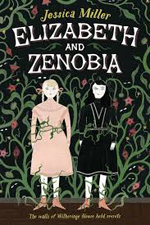 Following the unexpected departure of his wife, Dr. Murmur retreats to Withering House, his childhood home, to lose himself in his scientific work with his daughter, Elizabeth, and her best friend, Zenobia, in tow. Elizabeth is unsure about the creepy atmosphere of Withering House, but for Zenobia, who loves all things macabre, living at Withering House is an adventure. The weathered, stately mansion holds secrets from Dr. Murmur’s past which Zenobia is determined to ferret out. Timid Elizabeth reluctantly follows Zenobia on a ghoulish quest to contact the Spirit Presence that she is positive resides in the forbidden East Wing of Withering House. The girls uncover more than they bargained for, and Elizabeth must conquer her fears to confront ghosts from her father’s past and save them all from grave danger. Middle school readers will relish the humor as well as the gothic influences of this horror/mystery novel.
Following the unexpected departure of his wife, Dr. Murmur retreats to Withering House, his childhood home, to lose himself in his scientific work with his daughter, Elizabeth, and her best friend, Zenobia, in tow. Elizabeth is unsure about the creepy atmosphere of Withering House, but for Zenobia, who loves all things macabre, living at Withering House is an adventure. The weathered, stately mansion holds secrets from Dr. Murmur’s past which Zenobia is determined to ferret out. Timid Elizabeth reluctantly follows Zenobia on a ghoulish quest to contact the Spirit Presence that she is positive resides in the forbidden East Wing of Withering House. The girls uncover more than they bargained for, and Elizabeth must conquer her fears to confront ghosts from her father’s past and save them all from grave danger. Middle school readers will relish the humor as well as the gothic influences of this horror/mystery novel.
—KC
The Girl with the Ghost Machine. Lauren DeStefano. 2017. Bloomsbury.
 When Emmaline’s father begins building a ghost machine to bring back her deceased mother, it is as if Emmaline has lost both of her parents—her mother to the grave and her father to his obsession with the machine. Though Emmaline knows it’s preposterous to imagine the machine working, she has a sliver of hope that it could. But getting involved with spirits is risky business, and the ghost machine just might have some unintended consequences. This intriguing story of death, loss, family, and friendship will appeal to middle graders who enjoy ghost stories with a twist.
When Emmaline’s father begins building a ghost machine to bring back her deceased mother, it is as if Emmaline has lost both of her parents—her mother to the grave and her father to his obsession with the machine. Though Emmaline knows it’s preposterous to imagine the machine working, she has a sliver of hope that it could. But getting involved with spirits is risky business, and the ghost machine just might have some unintended consequences. This intriguing story of death, loss, family, and friendship will appeal to middle graders who enjoy ghost stories with a twist.
—RM
A Properly Unhaunted Place. William Alexander. Ill. Kelly Murphy. 2017. Margaret K. McElderry/Simon & Schuster.
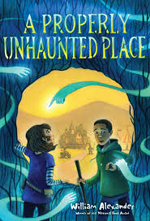 Rosa, the daughter of a ghost appeaser, can’t imagine living in a town without spirits, but that’s where she finds herself when she moves to Ingot, the world’s only “unhaunted” town. While Jasper, a lifelong Ingot resident who has never witnessed a haunting, is showing Rosa around Ingot’s Renaissance Festival, a supernatural creature invades the mermaid lagoon. The town of Ingot is about to change. Can Rosa and Jasper save the only ghost-free town in the world? This story keeps readers guessing until the very end. With its strong character development, humor, and unexpected twists, readers will lose themselves in a world filled with family, friendship, and the supernatural.
Rosa, the daughter of a ghost appeaser, can’t imagine living in a town without spirits, but that’s where she finds herself when she moves to Ingot, the world’s only “unhaunted” town. While Jasper, a lifelong Ingot resident who has never witnessed a haunting, is showing Rosa around Ingot’s Renaissance Festival, a supernatural creature invades the mermaid lagoon. The town of Ingot is about to change. Can Rosa and Jasper save the only ghost-free town in the world? This story keeps readers guessing until the very end. With its strong character development, humor, and unexpected twists, readers will lose themselves in a world filled with family, friendship, and the supernatural.
—ACS
Spirit Hunters. Ellen Oh. 2017. HarperCollins.
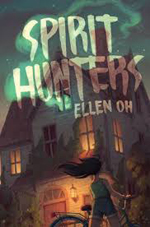 Twelve-year-old Harper is troubled. She knows something bad happened to her last year, something that landed her in a mental health hospital. Harper simply can’t remember, and nobody in her family will talk about it. Things become worse when Harper’s family moves into an old, supposedly haunted house, and her younger brother Michael’s personality takes a sudden turn from sweet and loving to angry and insolent. After being attacked by an unseen force in Michael’s room, Harper becomes convinced that his imaginary friend, Billy, might be a manipulative spirit. As Harper’s repressed memories surface, she realizes it is up to her to save Michael from Billy’s malevolence. But she’s going to have to be brave. Very brave. The swift action and increasing suspense of the plot will appeal to middle-grade readers, especially those who love a paranormal mystery.
Twelve-year-old Harper is troubled. She knows something bad happened to her last year, something that landed her in a mental health hospital. Harper simply can’t remember, and nobody in her family will talk about it. Things become worse when Harper’s family moves into an old, supposedly haunted house, and her younger brother Michael’s personality takes a sudden turn from sweet and loving to angry and insolent. After being attacked by an unseen force in Michael’s room, Harper becomes convinced that his imaginary friend, Billy, might be a manipulative spirit. As Harper’s repressed memories surface, she realizes it is up to her to save Michael from Billy’s malevolence. But she’s going to have to be brave. Very brave. The swift action and increasing suspense of the plot will appeal to middle-grade readers, especially those who love a paranormal mystery.
—DH
Ages 12–14
The Disappearances. Emily Bain Murphy. 2017. Houghton Mifflin.
 When 15-year-old Aila arrives in Sterling, her deceased mother’s hometown, she quickly realizes that something is not right. Soon Aila learns about the Disappearances; every seven years, some part of life disappears for good. Scent. Reflections. Color. Music. When Aila realizes her arrival in Sterling coincides with the next Disappearance, she hurriedly works to unravel the mystery of Sterling’s curse. Meanwhile, a reclusive stranger with long-forgotten ties to Aila’s family finds out she possesses something he wants—and he plans to get it no matter the cost. Mystery fans will love the convergence of two seemingly unrelated storylines at the novel’s dramatic conclusion.
When 15-year-old Aila arrives in Sterling, her deceased mother’s hometown, she quickly realizes that something is not right. Soon Aila learns about the Disappearances; every seven years, some part of life disappears for good. Scent. Reflections. Color. Music. When Aila realizes her arrival in Sterling coincides with the next Disappearance, she hurriedly works to unravel the mystery of Sterling’s curse. Meanwhile, a reclusive stranger with long-forgotten ties to Aila’s family finds out she possesses something he wants—and he plans to get it no matter the cost. Mystery fans will love the convergence of two seemingly unrelated storylines at the novel’s dramatic conclusion.
—DH
Poe: Stories and Poems. Gareth Hinds. 2017. Candlewick.
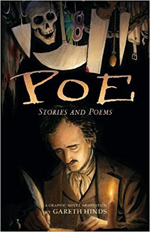 This graphic novel adaptation includes seven of Edgar Allen Poe’s most enduring short stories and poems: “The Masque of the Red Death,” “The Cask of Amontillado,” “Annabel Lee,” “The Pit and the Pendulum,” “The Tell-Tale Heart,” “The Bells,” and “The Raven.” While Poe’s tales are frightening on their own and have earned their rightful place as literary classics, the illustrations in this graphic novel heighten their horror and suspense for a new generation of readers. Much of Poe’s original text is retained, and the illustrations will aid young adults in their comprehension of the tales. As a bonus, Hinds includes an introductory “checklist” of horror motifs such as creepy animals, death, disease, and murder used by Poe, which are listed at the beginning of each story. An author’s note provides additional information on Edgar Allan Poe (1809–1849) and notes on the stories and poems Hinds selected for this volume.
This graphic novel adaptation includes seven of Edgar Allen Poe’s most enduring short stories and poems: “The Masque of the Red Death,” “The Cask of Amontillado,” “Annabel Lee,” “The Pit and the Pendulum,” “The Tell-Tale Heart,” “The Bells,” and “The Raven.” While Poe’s tales are frightening on their own and have earned their rightful place as literary classics, the illustrations in this graphic novel heighten their horror and suspense for a new generation of readers. Much of Poe’s original text is retained, and the illustrations will aid young adults in their comprehension of the tales. As a bonus, Hinds includes an introductory “checklist” of horror motifs such as creepy animals, death, disease, and murder used by Poe, which are listed at the beginning of each story. An author’s note provides additional information on Edgar Allan Poe (1809–1849) and notes on the stories and poems Hinds selected for this volume.
—DH
Ages 15+
A Good Idea. Cristina Moracho. 2017. Viking/Penguin.
 It is the final summer before starting college, and Finley is back in Williston, her coastal Maine hometown, after a tumultuous senior year in New York City. This summer is different. Her best friend, Betty, disappeared last fall. Did Betty run away, or did something more sinister happen? Finley is enraged when she learns no one in Williston seems to care what happened to Betty. Aided by Serena, her new love interest, Finley is determined to learn the truth about Betty’s disappearance. But before she does, Finley must uncover Williston’s unsavory secrets and peel back the many layers of Betty’s troubled life. Finley’s growing despair and the bleakness of the cold, rainy summer set the perfect mood for this fast-paced, dark thriller. A Good Idea will keep older teens up all night as they race through the pages to learn what becomes of Betty.
It is the final summer before starting college, and Finley is back in Williston, her coastal Maine hometown, after a tumultuous senior year in New York City. This summer is different. Her best friend, Betty, disappeared last fall. Did Betty run away, or did something more sinister happen? Finley is enraged when she learns no one in Williston seems to care what happened to Betty. Aided by Serena, her new love interest, Finley is determined to learn the truth about Betty’s disappearance. But before she does, Finley must uncover Williston’s unsavory secrets and peel back the many layers of Betty’s troubled life. Finley’s growing despair and the bleakness of the cold, rainy summer set the perfect mood for this fast-paced, dark thriller. A Good Idea will keep older teens up all night as they race through the pages to learn what becomes of Betty.
—DH
The Special Ones. Em Bailey. 2017. Houghton Mifflin.
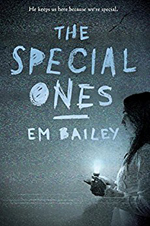 Esther has spent two years as part of the Special Ones: an ominous cult living a “simple” life on a secluded farm. She was chosen by the cult leader, who none of the Special Ones has seen. He, supposedly, is constantly watching them, making sure they are playing their parts as spirit guides and following his rules. The Special Ones live one day at a time, fearful of “renewal.” Although they have no idea what happens when a Special One is renewed, they suspect nothing good will come from it. Esther feels that she can no longer keep up the act of obedience she puts on. Is it her time to be renewed, or will she continue to live this troublesome lie? The progression and ending of the book will leave readers shocked, wanting more of the troubling story of Esther and the Special Ones.
Esther has spent two years as part of the Special Ones: an ominous cult living a “simple” life on a secluded farm. She was chosen by the cult leader, who none of the Special Ones has seen. He, supposedly, is constantly watching them, making sure they are playing their parts as spirit guides and following his rules. The Special Ones live one day at a time, fearful of “renewal.” Although they have no idea what happens when a Special One is renewed, they suspect nothing good will come from it. Esther feels that she can no longer keep up the act of obedience she puts on. Is it her time to be renewed, or will she continue to live this troublesome lie? The progression and ending of the book will leave readers shocked, wanting more of the troubling story of Esther and the Special Ones.
—ABS
Danielle Hartsfield is assistant professor in the Teacher Education Department at the University of North Georgia in Cumming. Kristina Chérres, Rebekah Mitchell, Selena Rosario, Alexis B. Sharbel, and Amanda C. Shreve are all seniors majoring in Elementary and Special Education at the University of North Georgia. They are currently enrolled in Hartsfield’s Children’s Literature and Language Arts class.
These reviews are submitted by members of the International Literacy Association's Children's Literature and Reading Special Interest Group (CL/R SIG) and are published weekly on Literacy Daily.